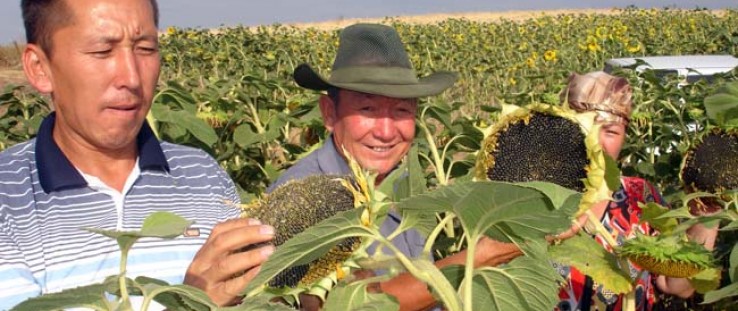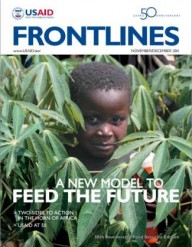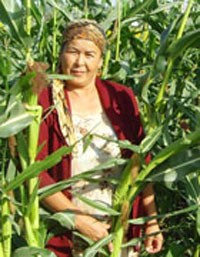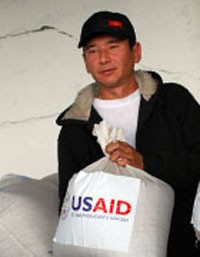 USAID’s Kyrgyz Agro-Input Enterprise Development project helped to stimulate the production of 2,500 metric tons of corn and sunflower for high-quality edible oil. Over 800 farmers and 50 seed producers received training on modern cultivation.
CREDIT: GULJAMAL CHOKMOROVA, KAED
USAID’s Kyrgyz Agro-Input Enterprise Development project helped to stimulate the production of 2,500 metric tons of corn and sunflower for high-quality edible oil. Over 800 farmers and 50 seed producers received training on modern cultivation.
CREDIT: GULJAMAL CHOKMOROVA, KAED
 USAID’s Kyrgyz Agro-Input Enterprise Development project helped to stimulate the production of 2,500 metric tons of corn and sunflower for high-quality edible oil. Over 800 farmers and 50 seed producers received training on modern cultivation.
CREDIT: GULJAMAL CHOKMOROVA, KAED
USAID’s Kyrgyz Agro-Input Enterprise Development project helped to stimulate the production of 2,500 metric tons of corn and sunflower for high-quality edible oil. Over 800 farmers and 50 seed producers received training on modern cultivation.
CREDIT: GULJAMAL CHOKMOROVA, KAED
It seems that tiny, landlocked Kyrgyzstan has seen it all in recent years: drought, harsh winters, ethnic tension, and a popular uprising. As a result of these challenges, both natural and man-made, an estimated 47 percent of the population lives in fear of hunger or starvation or is otherwise considered food insecure. Economic opportunity is also constrained by the fact that two-thirds of the country’s 5 million inhabitants live in rural areas, yet only 7 percent of the land is arable.
USAID has been active in Kyrgyzstan since the country’s independence in 1992, and opened an office a year later to support the transition to a market economy. USAID’s early programs were focused on unleashing private-sector growth and creating access to finance for small businesses. While this support allowed Kyrgyzstan’s shopkeepers and traders to improve their cash flow, the country’s small farmers lacked the quality fertilizer or adequate machinery to adapt to a demand-driven agricultural market. Farm production in Kyrgyzstan is made more uncertain by frequent water shortages, flooding, border closures, and social unrest.
Persistent threats to the food supply in the country prompted USAID to move beyond stopgap assistance and develop a sustainable solution. In 2001, the Agency invested $1 million in a two-year pilot project with the International Fertilizer Development Center (IFDC) to facilitate trade and technology transfer between agro-input dealers and farmers in southern Kyrgyzstan. Crop yields dramatically increased between 25 and 35 percent, a resounding success, which stimulated additional USAID investment in the Kyrgyz Agro-Input Enterprise Development (KAED) program. USAID extended its support to IFDC in 2003 to reach more farmers, and in 2006 to replicate the program’s successes in northern Kyrgyzstan, and again in 2008 to respond to a food crisis.
In 2009, while the Agency was expanding this partnership, it identified a new private-sector alliance with the Eurasia Group LLC Switzerland—Pioneer, John Deere, DuPont, and Monsanto. Together, they built upon the previous successes of KAED to help move the country beyond subsistence agriculture, toward greater food security.
The current project, known as KAED Follow-On, was formed through a USAID Global Development Alliance (GDA)—the premier model for public-private partnerships since 2001. At its core, GDA reflects the current realities that a project able to sustain itself through the capital marketplace is more likely to survive, and that, says Erin Cole, USAID’s GDA liaison in Central Asia, “many of the largest issues in development require solutions that no single actor could hope to tackle alone.”
Increasing food security is a major U.S. international development goal, and creating sustainable new markets and supply chains is a necessity for the private sector. “Over the course of our two-year partnership with the Eurasia Group, both these goals are being met in a sustainable way,” said Cole. Through the partnership, farmers receive a supply of high-quality seed, crop-protection products, and access to the newest agricultural technology and machinery at subsidized prices.
Pioneer is providing quality hybrid seeds to farmers while Du Pont and Monsanto are contributing a range of products to protect their crops. John Deere has contributed $1.95 million worth of agricultural machinery, including tractors, planters, cultivators, sprayers, and harvesters required during the growing season. These critical agro-inputs complement USAID’s technical assistance program, which provides business training to 120 local input dealers and distributors, cultivation and product usage trainings to 750 commercial farmers, and other activities to link farmers with output markets.
As a result of a decade-long effort in Kyrgyzstan, roughly 123,000 commercial and smallholder farmers have received USAID support, and are able to produce enough for commerce and larger distribution. Producing 4,000 metric tons of winter wheat, for the first time in many years, the country met the annual demand for wheat harvests with a record-making yield in 2009. Bread wheat production increased by 40,000 metric tons to a total of 1.2 million, the highest production level in Kyrgyzstan in the last 15 years.
“The results exceeded my best expectations,” said Kurbanaly Mitiev, a farmer from northern Kyrgyzstan. “I was very happy not only with the high yield, but also with the quality of the seeds that had high output, which meant that I could sell my seeds for a better price.”
Additionally, 1,200 kilograms of livestock feed was distributed through private-sector markets to ensure the survival of a targeted 70,000 dairy cows (14 percent of all dairy cows in Kyrgyzstan) during the 2008-2009 winter months. The mortality rate among these animals was just 3.6 percent, compared with 13.5 percent for unassisted animals. Among program-assisted farms, the average milk yield rose 26 percent from the same period the previous year.
The combination of a highly productive crop yield and an effective livestock management campaign during the particularly cold winter months staved off what would have surely been a food crisis.
“Through our technical assistance activities, partnerships with private companies, and the provision of U.S.-financed fertilizer and seed to over 40,000 farmers, project beneficiaries have already improved yields in key food and feed crops by 20 percent,” said Hiqmet Demiri, chief of party for the program.
A Foundation for Food Security
Just as the original KAED project was ending in the spring of 2010 and the project was celebrating the successful 2009 harvest, political turmoil and ethnic violence in Kyrgyzstan jeopardized the agricultural supply system, making seed, fertilizers, and other agro-inputs scarce. Kyrgyzstan’s southern communities around Osh and Jalalabad were most affected by a sudden wave of ethnic violence in June 2010 that displaced thousands of citizens from their homes and disrupted local markets.
To counter the agricultural setbacks caused by the unrest and ensure the stability of the program, USAID, the IFDC, and the Eurasia Group LLC Switzerland joined together to support the KAED Follow-On project for additional seed and funding to recover the high output from 2009.
The successes of the KAED and KAED Follow-On projects have transformed the program into a household name throughout the country. It currently works with 20,000 farmers to plant USAID-funded improved wheat varieties and 80,000 farmers to collaborate with private-sector partners and adopt “best practices” in farming and animal care.
“[USAID’s] support significantly reduced the shortage of seed material in the country, expanded the acreage sown with crops compared to last year, and increased the use of high-quality certified varieties and hybrids,” said Torogul Bekov, Kyrgyzstan’s minister of agriculture. “This will set the stage for receiving high yields of agricultural crops in the future.” Since opening Kyrgyzstan’s relatively small and isolated agricultural market to large international suppliers, over 40 new business relationships have been established with an initial value of $4 million and growing. The Association of Agribusinessmen of Kyrgyzstan, a non-profit organization established with the support and assistance of the KAED project to represent and coordinate the work of the country’s agriculture producers, suppliers, and dealers, has been instrumental in fostering the growth of budding Kyrgyz agro-businesses as they enter world markets.
USAID and a local Kyrgyz company—Oasis Agro, LLC—have also created a new public-private partnership to promote poultry and high-value feed crops. The partnership is providing farmers with training and access to key business resources in the feed and poultry industries, thus improving production of high-quality edible oil and eggs.
Because of the project’s success in Kyrgyzstan, talks with private-sector partners have already begun in an effort to expand the program to other countries in Central Asia.
A New Model for a New Century
The private sector has always had a significant role in development, but the benefit of public-private partnerships is becoming an increasingly important part of sustainable development. In 2001, USAID embraced a new approach to partnerships that fully welcomes and encourages direct collaboration with the private sector. The move was driven by the recognition that new stakeholders were making significant contributions to international development and developing countries. These new actors included non-governmental organizations (NGOs), private voluntary organizations (PVOs), cooperatives, faith-based organizations, foundations, corporations, financial institutions, the higher education community, remittances from diaspora communities, and even individuals.
In light of this new reality, USAID launched the GDA model of public-private partnerships in 2001 to deepen the scale, impact, and sustainability of its development programs. With more than 900 alliances formed with over 1,700 distinct partners over the past decade, the Agency has not looked back. According to alliance officer Cole, “The GDA program was designed to combine the assets and experience of strategic partners and to leverage their capital, investments, creativity, access to markets, and skills to solve complex problems facing government, businesses, and communities.”
The continued GDA partnership between USAID and the Eurasia Group LLC Switzerland is a result of persistent efforts to attract international companies to the relatively small Kyrgyz market. This alliance has already proven to be a mutually beneficial and effective relationship that will be expanded through the KAED Follow-On project.
“The alliance serves as a prime example of how public-private partnership can address food security issues through increased agricultural productivity. KAED hopes its successes will serve as a signal to other firms in the region and lead to new public-private initiatives that address food security needs,” said Demiri.











Comment
Make a general inquiry or suggest an improvement.